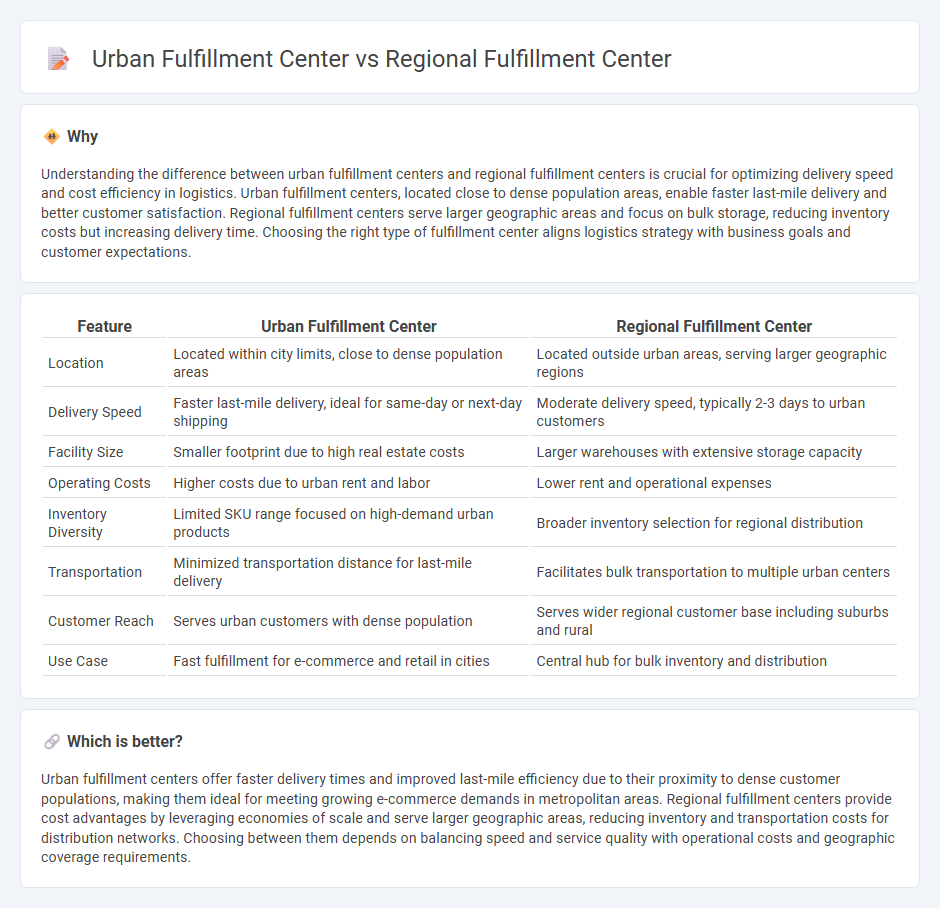
Urban fulfillment centers prioritize rapid delivery within densely populated areas, leveraging proximity to consumers to reduce shipping times and last-mile costs. Regional fulfillment centers focus on bulk storage and distribution, serving a broader geographic area with higher inventory capacity and optimizing overall supply chain efficiency. Explore how these fulfillment strategies impact your logistics operations and customer satisfaction.
Why it is important
Understanding the difference between urban fulfillment centers and regional fulfillment centers is crucial for optimizing delivery speed and cost efficiency in logistics. Urban fulfillment centers, located close to dense population areas, enable faster last-mile delivery and better customer satisfaction. Regional fulfillment centers serve larger geographic areas and focus on bulk storage, reducing inventory costs but increasing delivery time. Choosing the right type of fulfillment center aligns logistics strategy with business goals and customer expectations.
Comparison Table
| Feature | Urban Fulfillment Center | Regional Fulfillment Center |
|---|---|---|
| Location | Located within city limits, close to dense population areas | Located outside urban areas, serving larger geographic regions |
| Delivery Speed | Faster last-mile delivery, ideal for same-day or next-day shipping | Moderate delivery speed, typically 2-3 days to urban customers |
| Facility Size | Smaller footprint due to high real estate costs | Larger warehouses with extensive storage capacity |
| Operating Costs | Higher costs due to urban rent and labor | Lower rent and operational expenses |
| Inventory Diversity | Limited SKU range focused on high-demand urban products | Broader inventory selection for regional distribution |
| Transportation | Minimized transportation distance for last-mile delivery | Facilitates bulk transportation to multiple urban centers |
| Customer Reach | Serves urban customers with dense population | Serves wider regional customer base including suburbs and rural |
| Use Case | Fast fulfillment for e-commerce and retail in cities | Central hub for bulk inventory and distribution |
Which is better?
Urban fulfillment centers offer faster delivery times and improved last-mile efficiency due to their proximity to dense customer populations, making them ideal for meeting growing e-commerce demands in metropolitan areas. Regional fulfillment centers provide cost advantages by leveraging economies of scale and serve larger geographic areas, reducing inventory and transportation costs for distribution networks. Choosing between them depends on balancing speed and service quality with operational costs and geographic coverage requirements.
Connection
Urban fulfillment centers focus on rapid last-mile delivery within dense metropolitan areas, leveraging proximity to customers for expedited order fulfillment. Regional fulfillment centers handle larger inventory volumes and bulk shipments, feeding urban centers with a steady supply of products. This hierarchical relationship optimizes supply chain efficiency by balancing inventory storage and speedy local delivery.
Key Terms
Distribution Radius
Regional fulfillment centers typically serve a broad distribution radius, covering large geographic areas to optimize bulk storage and cost efficiency for nationwide or multi-region deliveries. Urban fulfillment centers focus on a smaller distribution radius within densely populated metropolitan areas to enable faster, last-mile delivery and enhanced customer convenience. Explore more to understand which center best aligns with your logistics strategy and customer service goals.
Inventory Density
Regional fulfillment centers typically maintain higher inventory density by storing a broad range of products in larger quantities to serve wide geographic areas efficiently. Urban fulfillment centers focus on maximizing inventory density through smaller, carefully curated selections tailored for rapid, last-mile delivery within dense metropolitan zones. Explore the strategic benefits of balancing inventory density between regional and urban fulfillment centers to enhance supply chain performance.
Last-Mile Delivery
Regional fulfillment centers strategically store inventory closer to broad geographic markets, optimizing cost-efficient last-mile delivery over larger service areas. Urban fulfillment centers operate within metropolitan zones, enabling ultra-fast delivery and same-day shipping by leveraging proximity to dense customer bases. Explore how these fulfillment models transform last-mile logistics and customer experience.
Source and External Links
Differences Between Distribution Centers & Fulfillment Centers - Regional fulfillment centers are specialized warehouses focused on processing high volumes of individual orders for ecommerce and retail, enabling fast picking, packing, and shipping to end customers within a region, contrasting with distribution centers that handle bulk inventory shipments primarily to retailers.
Regional warehouse: Supply chain advantages - Regional fulfillment centers act as key supply chain nodes that consolidate inventory from multiple suppliers, reduce delivery times by being closer to customers, optimize shipment routes and costs, and improve product availability to meet local demand effectively.
How Amazon reworked its fulfillment network to meet customer demand - Regional fulfillment centers help companies like Amazon increase delivery speed and logistics efficiency by concentrating the majority of order volume within a few centers per region, reducing transportation distances and simplifying network management.
 dowidth.com
dowidth.com